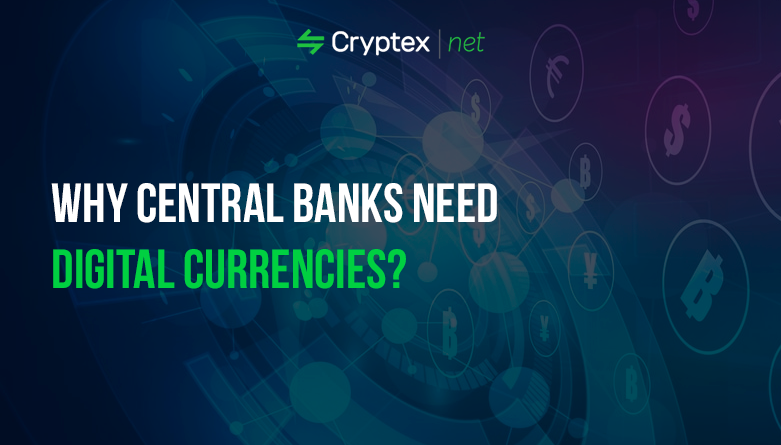Why central banks need digital currencies
24.04.2021 | asorokin

Analysts have repeatedly called digital currencies of central banks the defining stage in the development of global monetary policy for the next few decades. At the same time, the Bank for International Settlements said that up to 70% of regulators around the world are studying the possibility of issuing their own digital currencies. And the coronavirus pandemic that began in 2019 has only accelerated work in this direction.
After studying report on CBDC, it is clear that many Central Banks in developing countries are banking on an innovative form of money. However, upon closer review:
-
few regulators are ready to launch their own digital currency in the next five years;
-
during pilot tests it became clear that it will not be possible to fully assign all functions to the regulator, it is necessary to negotiate with the private sector and delegate some powers to them;
-
from the preceding - most projects involve a two-tiered system of national digital currency;
-
CBDC can coexist with private secured cryptocurrencies;
-
If the regulator desires, the digital currency can realize the necessary level of privacy and anonymity.
What pushes central banks to issue a digital national currency
To date, all national regulators are already issuing “virtual” money. In fact, all bank deposits, including card accounts, can be called digital currency. Although CBDC is different in its technical implementation and will take the global economy to the next level, there is not much difference for the end consumer. So why are central banks in most countries considering launching a new format of money?
Nowadays the financial system, familiar to many people, is under enormous pressure: banks are being replaced by new high-tech companies, in particular payment systems, free cryptocurrencies are increasingly trusted by users and attract some depositors, against the background of another crisis, trust in banking structures, especially in developing countries, is decreasing.
To solve all these problems the authorities and central banks have to keep up with the times and develop new payment formats.
CBDC will increase competition in the financial market, while increasing the stability of its work. Reduction of the cost of maintaining the economic model and the monetary policy of the regulator should not be missed as well. The new format of money will create a new payment infrastructure, which will enable the Central Bank to manage the economy, which is increasingly going digital.
According to many analysts, the Central Bank’s digital currency will reduce the dollarization of a number of countries, and developed countries will avoid the trap of zero key rates. Transparency of use and flexibility of programming principles will ensure greater reliability.
Why retail CBDC might be needed
A commercial form of digital currency seems preferable to many regulators - it’s easier to manage the financial system. But only retail CBDC are suitable for more widespread implementation. Only the latest type can fully replace traditional currencies and be used in commodity turnover to pay for goods and services.
Regulator in Sweden was the first in the world to talk about a new form of national digital currency. In this country, the least amount of payments is made in cash, only 5% of households pay with paper money. The digital krone appeared in test mode back in 2017. Last year, the testing moved into the pilot stage.
The next interesting project was the digital peso. Uruguay, the leader in South America, also launched CBDC test in 2017. The test lasted eight months and was conducted between ordinary people. Unlike their Swedish counterparts, the Uruguayans decided to use an electronic wallet system with a cryptographic signature of each unit instead of blockchain technology. The digital peso could be used to pay anonymously, which is not supported by the Central Banks of many countries.
Commercial CBDC
Commercial digital currencies are designed primarily for use in the banking sector. They are used for payments in interbank settlements, clearing and international transactions, where the bank may act as a collateral guarantor. This type of CBDC is similar in its properties to the already existing system, when the regulator makes issuance, accumulating funds in special accounts, providing access for retail banks.
The main differences of the innovation from the existing practice are:
-
round-the-clock access to the money, currently all applications are approved by the Central Bank in manual mode;
-
recording of all actions in a special system, which is a distributed register;
-
reducing credit risks - all borrowed funds can be tracked by counterparties, which will increase transparency and trust in settlements.
Commercial digital currencies are already at some stage of development in Europe, Japan, Canada, Singapore and Hong Kong. And while many consider the use of distributed ledgers to be optional when launching CBDC, most tests are done using one of the three platforms:
-
R3 Corda,
-
Quorum,
-
Hyperledger Fabric.
European and Japanese Central Banks also tested the possibility of anonymizing transfers. For this purpose, a special electronic voucher was issued, in which it was enough to specify the data of the beneficiary. In this case the regulator did not check the payer’s data, however, such transfers have not been supported by the authorities yet.
Conclusion
With all the interest from the Central Bank to the innovative means of payment in the near future the mass introduction should not be expected. The largest economy in the world, which is the U.S., is still only considering the possibility of a digital dollar, the Federal Reserve is waiting for approval of the authorities. But even now, many American companies and local governments use free cryptocurrencies. Over the years, America has developed a fairly liberal financial model, which makes it possible to use economic innovation without having to go through complicated approval procedures.